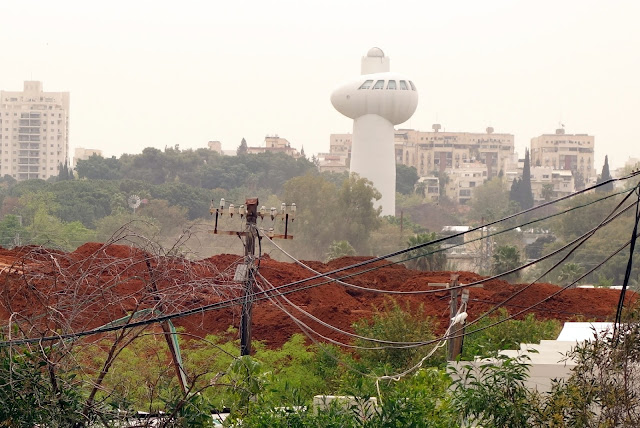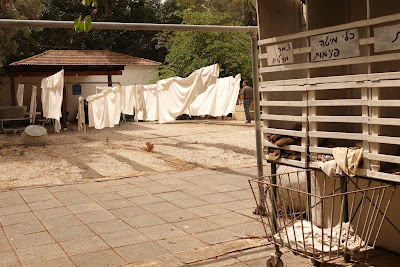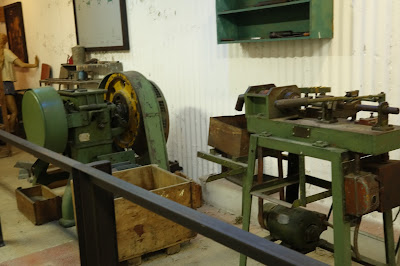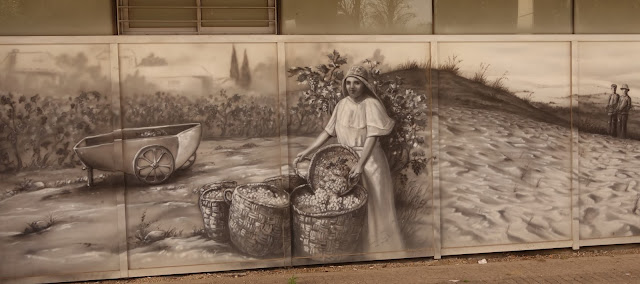The map of Rehovot below is out-of-date as the Hi-Tech Park is already in existence. The hidden ammunitions factory is under #7 where "you are here" is written.
You can also see the Weitzman particle accelerator tower from the front porch.
 |
| Entrance hours and phone number |
 |
| The sentry box |
 |
| The entrance. Fee was just 20 shekels for me, or a bit over $5. |
 |
| Picture of the kibbutz in the 1940s |
 |
| Early pictures |
 |
| The site still has some chickens as a reminder of the animals kept in the small kibbutz training site above ground |
 |
| We walked in a non-descript door and watched a movie about the history of the site |
Since the British did not allow the Jews in Palestine to obtain weapons, they had to do so illegally. They managed to get weapons but they needed ammunition--i.e. bullets. In 1938, Yehuda Harazi, a bold arms purchaser, bought 12 machines to be used to make bullets and managed to smuggle them into Palestine. It took a while as it was illegal to buy the machines in Poland as Poles wanted people to buy ammo from them. They did manage to fool a Polish soldier on guard by threatening to call his officer and smuggled the machines, in parts, to Beirut. They waited two years there and managed to send the machines as "parts of textile machines" and completely fooled the British.
They had to figure out where to secretly make the bullets. If the workers on this project had been caught, they would have been jailed and probably executed.
It was decided to use Har Hakibbutzim, a hill hear Rehovot which could be dug into to make a hidden ammo factory and a kibbutz training area on top. They managed to do it under the British soldiers' noses. Forty -five young men and women between 18 and 22, under total secrecy, worked in the underground factory, without telling anyone what they were doing. They alternated working in the factory and working in the small kibbutz above ground. Workers on the kibbutz that knew nothing about the secret factory were called "giraffes."
After the movie, we walked into the laundry. On the outside it looked like a typical kibbutz laundry drop off site for dirty clothes. A laundry was chosen as the "business" above the factory as the washing machines made lots of noise and could cover up the sounds below.
In the second picture, laundry was drying in the wind as kibbutzim did not have dryers then.
And inside it looked normal too: The woman at the sewing machine was named Esther. She started working downstairs but was allergic to gun powder so she worked upstairs and was the key person to make sure everything was ok, to lock up, etc.
The laundry was so successful that British soldiers also used it. To keep them from coming to the kibbutz less often, the group opened a laundry shop in Rehovot. Another benefit was that the workers often found notes in the British soldier's pants pockets that were useful to them.
 |
| Entrance under big washing machine to hidden factory over 40 feet below |
A bakery was right next to the laundry, and the baker was so good that lots of people wanted his bread.
Below is the staircase that went down 25' from the bakery to the ammo factory.
 |
| 9 mil bullet production |
The bullets were tested every 1.5 hours in a small shooting range. They did it at that time because that is when the (noisy) British trains came by, drowning out the sounds of the bullets.
The final and most important part of the ammunition factory was when the gun powder was put in the shell casing. Too much or too little gun powder could result in an explosion. And the children's house was right above the room where this was done.
 |
| pictures of daily life above ground on the kibbutz in the late 1940s |
Thank goodness, there was never an explosion. One of the women on the tour could not understand how the secret workers could endanger the lives of their children. She could not understand that they had no choice. If they could not continue their work in secret, there would be no ammunition, and all would die.
Under the kill--the secret bullet factory!


































































